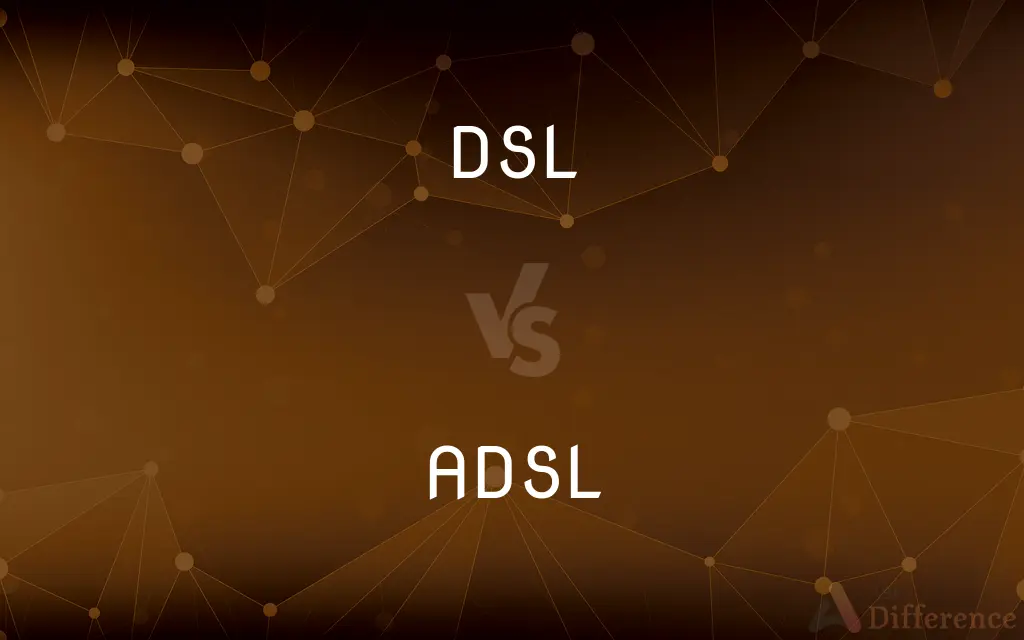DSL vs. ADSL — What's the Difference?
By Tayyaba Rehman — Published on October 20, 2023

Difference Between DSL and ADSL
Table of Contents
ADVERTISEMENT
Key Differences
DSL, standing for Digital Subscriber Line, represents a group of technologies used to provide internet over traditional copper telephone lines. ADSL, which stands for Asymmetric Digital Subscriber Line, is a subset of DSL, meaning that all ADSL connections are DSL, but not all DSL connections are ADSL.
One of the main characteristics differentiating DSL and ADSL is how they manage data transmission speeds. While DSL is a more generic term that simply denotes digital data transmission over phone lines, ADSL specifically refers to a type of DSL where the download speed (from the internet to the user) is faster than the upload speed (from the user to the internet). This asymmetry in speeds aligns well with most users' internet habits, as they often download more content than they upload.
Another distinction between DSL and ADSL is their availability and use in the market. While there are different types of DSL technologies, such as SDSL (Symmetric Digital Subscriber Line) where upload and download speeds are equal, ADSL remains the most commonly deployed type of DSL in many regions. This is mainly because the average internet user consumes more content (downloads) than they produce (uploads).
Lastly, it's important to understand that while ADSL is a type of DSL, the term "DSL" on its own doesn't provide specifics about the symmetry or asymmetry of data transmission speeds. Therefore, when considering internet options, users should seek detailed specifications to understand the exact offering, be it ADSL, SDSL, or another variant of DSL.
Comparison Chart
Definition
Digital data transmission over phone lines
DSL type with asymmetric upload/download speeds
ADVERTISEMENT
Speed Symmetry
Can be symmetric or asymmetric
Always asymmetric
Common Usage
General term for various DSL technologies
Most common DSL type for home internet
Upload/Download
Speeds vary based on DSL type
Faster download than upload
Subset Relationship
Broad category of technologies
A specific type of DSL
Compare with Definitions
DSL
A technology for digital data transmission.
My home uses a DSL connection for internet.
ADSL
Uses phone lines for digital data transmission.
ADSL brings high-speed internet over existing phone lines.
DSL
Uses copper telephone lines for internet.
Even with fiber-optic available, many still use DSL for their connectivity.
ADSL
A type of DSL with asymmetric speeds.
Most households prefer ADSL due to its faster download rates.
DSL
Provides internet connectivity.
We're getting a DSL line installed next week.
ADSL
Common choice for home internet.
The technician set up an ADSL connection for us.
DSL
A broad category encompassing various technologies.
There are multiple types of DSL services, depending on the provider.
ADSL
Prioritizes download speed over upload.
ADSL works best for users who download more than they upload.
DSL
Operates over traditional phone infrastructure.
DSL technology revitalized the use of old phone lines.
ADSL
Subset of the broader DSL category.
While we discussed various DSL options, we settled on ADSL.
DSL
Any of various technologies used to create high-bandwidth network connections over standard telephone lines, often in providing internet service to homes.
DSL
A generic name for digital lines that are provided by telephone companies to their local subscribers and that carry data at high speeds
Common Curiosities
Can I use my phone line for DSL and regular calls simultaneously?
Yes, DSL operates at higher frequencies, allowing simultaneous use with voice calls.
Why is ADSL more common for home use?
ADSL's faster download speeds match typical home user behaviors, like streaming and browsing.
What does DSL stand for?
DSL stands for Digital Subscriber Line.
Does ADSL require a separate phone line?
No, ADSL can operate on the same line as voice calls.
Does DSL require any special equipment?
Yes, DSL requires a modem to connect to the internet.
Are there limitations to ADSL's reach?
Yes, ADSL speeds decrease the further you are from the service provider's central office.
How does ADSL differ from DSL?
ADSL is a type of DSL with different upload and download speeds.
How does ADSL achieve asymmetric speeds?
ADSL divides the bandwidth of the phone line, allocating more to downloading than uploading.
Are there other types of DSL besides ADSL?
Yes, there are various types like SDSL, VDSL, among others.
Is ADSL faster than DSL?
ADSL is a form of DSL; its speed depends on the specific implementation and distance from the service provider.
What affects the speed of an ADSL connection?
Distance from the provider, line quality, and network congestion can impact speeds.
Why might someone choose DSL over fiber-optic?
DSL might be more readily available, affordable, or sufficient for their needs.
Is DSL suitable for gaming and streaming?
Yes, but the experience depends on the specific DSL speed and stability.
What is the main advantage of DSL?
DSL can use existing phone lines, making it widely accessible.
Can I upgrade from DSL to ADSL?
If you already have DSL, you likely have ADSL as it's a subtype of DSL. Check with your provider for specific offerings.
Share Your Discovery

Previous Comparison
Direct Democracy vs. Indirect Democracy
Next Comparison
Feminism vs. Gender EqualityAuthor Spotlight
Written by
Tayyaba RehmanTayyaba Rehman is a distinguished writer, currently serving as a primary contributor to askdifference.com. As a researcher in semantics and etymology, Tayyaba's passion for the complexity of languages and their distinctions has found a perfect home on the platform. Tayyaba delves into the intricacies of language, distinguishing between commonly confused words and phrases, thereby providing clarity for readers worldwide.














































